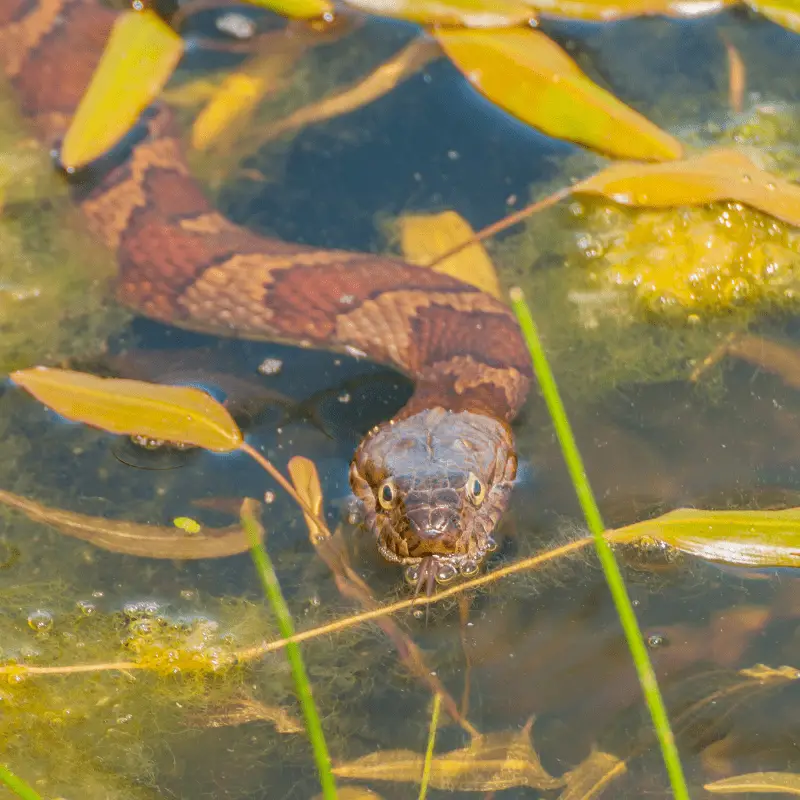Snakes are one of the earth many mysteries, and if you’re like me, you want to know everything you can about them, even down to how they breathe and if they can breathe underwater. Every living thing needs to breathe, and not all can breathe underwater. It would help if you had gills like a fish to breathe underwater. We might be able to breathe out underwater, but we certainly can’t breathe in. Another way of breathing underwater is how a mammal breathes; they take in the oxygen via their blowhole and then breathe it out underwater; however, they can hold their breath for an extended period. If you have ever seen a snake, you will know that they have no such gills or a blowhole as mammals. Even water snakes that mainly live in the water don’t have gills. Let’s find out if snakes can breathe underwater and why they choose to live underwater?
No, a snake can not breathe underwater; however, it can hold its breath for quite some time that you may think it can breathe underwater. Snakes need oxygen, just like us humans. They do not have gills like an eel or a fish. A snake will need to resurface now and then to fetch oxygen.
How long can a snake hold its breath underwater?
The length of time can vary between snake species. Snakes can hold their breath underwater from 10 minutes up to 2hrs. Water snakes have adapted their lungs to withstand 2 hours underwater, holding their breath. However, the standard corn snake can only manage 10 minutes max.
A snake can hold its breath for more extended periods when they are calm. Like us, we can get out of breath, and if a snake is getting chased by prey, this will affect the time they can calmly hold their breath.
How do snakes breathe?
Snakes have nostrils and can breathe via these or breathe in and out by their glottis. The glottis is a small opening located at the back of the tongue, opening into the windpipe to allow air to travel to the lungs.
The respiratory system of a snake
Snakes can have two lungs, however one primary functioning lung only. In most cases, the left vestigial lung is very small or non-existent, otherwise not needed. The right lung is the central lung that is used within a snake.
As we already know, sea snakes can hold their breath longer than a corn snake, and this is because they have an even longer lung, which extends throughout their entire body, allowing them to store more oxygen for use later.
Diaphragm
Snakes do not have a diaphragm to help them to breathe, unlike us humans. Snakes rely on their muscles to breathe, just like they depend on them to move—the muscles contract around the ribs, enabling the snake to inhale and exhale.
How long is the main right lung?
The primary right lung will take up just under a quarter of a snakes body length. However, water snakes lungs can be nearly the whole length of the snake’s torso, enabling them to hold their breath for more extended periods.
Internal organs of a snake pic
What snakes can hold their breath underwater the longest?
- Water snakes
- Coral Reef snakes
- Water Moccasins
Snakes that live in the sea, or by the sea, have adapted their lungs to underwater. Snakes have been around for millions of years, and in this time, they can evolve to their surroundings.
What snakes can hold their breath underwater the shortest?
- Corn snake
- Anaconda
- Horned Desert Viper
- Sidewinder snake
The above snakes all have something in common they don’t often come into contact with much water. Some snakes live in the desert like the Horned Desert Viper, and like the Corn snake species, some live in dry fields. This meaning they dont need to adapt to living in water as some snakes do.
Did you know? The organs line up in a line within the snake’s body, so the kidneys are behind each other, not side to side like ours. It truly is remarkable how we are all built and how we adapt to our surroundings.
Conclusion
Snakes can’t breathe underwater as we thought. Snakes that live by the sea or in the ocean have adapted their lungs to hold their breath longer. But we now know they certainly can’t breathe underwater like a fish. I hope this has cleared up your question and given you an insight into how the lungs of a snake work.

